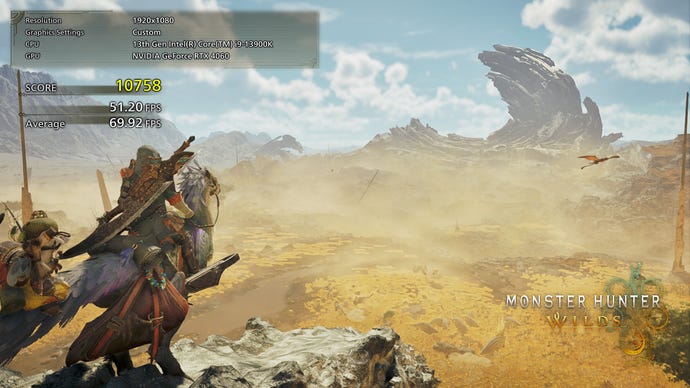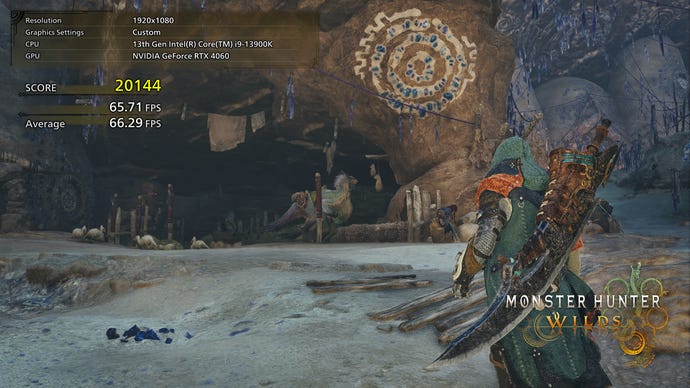True to the word of Capcom’s German social media marketing, Monster Hunter Wilds has a new, generally less extravagant set of PC system requirements ahead of its February 28th launch. There’s also a standalone benchmark tool that you can download from the game’s Steam page, so you can see for yourself how the beast-biffing RPG will run on your hardware.
In theory, these are great developments. Lower requirements mean a more widely accessible game, and the benchmark tool – which covers a good six minutes of combined cinematics and simulated free roaming – brings reassurance and accountability to this otherwise hype-reliant prerelease period. Sadly, there are two problems. One, the benchmark confirms outright that Monster Hunter Wilds will run like stagnant goulash on low-end PCs, and two, it does so to the extent that I’m not sure that the revised minimum specs are even reliable.
Besides the remarkable drop from 140GB to 75GB of required SSD space – Dr. Weird would approve – the new min specs typically tone down their CPU and graphics card asks by one step. The minimum Nvidia GPU, for example, has dropped from the GTX 1660 Super to the standard GTX 1660, and you can supposedly get away with an Intel Core i5-10400 rather than the previously listed Core i5-10600. Cool! Except the stipulation remains that these will only manage 1080p when employing both upscaling and frame generation, which Wilds supports in Nvidia DLSS 3 and AMD FSR 3.1 varieties.

This isn’t how frame generation is supposed to be used, at all. Because it requires a high ‘base’ of ordinarily rendered frames to both insert interpolated frames and to offset its added input lag, frame gen’s real use is to take games that already run well and make them look properly, bleeding-edge silky. Relying on it to artificially push a PC-melter past 30fps is daft because it will still tangibly feel, from the lack of input responsiveness, like it’s running at 20fps or 15fps or whatever. Which, in terms of ‘real’ frames, it is.
MHW’s benchmark tool shows this in action. Since I don’t have a GTX 1660, I was a bit cheeky and tested a GTX 1060 instead, though left in my test rig’s overpowered Core i9-13900K to help make up the difference. At 1080p with the Lowest preset and FSR upscaling working on its (hideous) Ultra Performance mode, I ended up with an average of just 26fps, with sustained drops to 17-20fps during the open world bits. With frame generation, the average rose to 45fps, but in an actual game-playing scenario that would feel crap because your controller or mouse/keyboard inputs are only registering for half the visible frames.
Moreover, the GTX 1660 is only slightly faster than the GTX 1060 on a good day, so even if you follow the minimum specs, by the benchmark tool’s own admission you’d keep getting these painful sub-30fps dips. There’s bad news here for the Steam Deck as well: the benchmark does run, but on that same Lowest/FSR Ultra Performance combination, it averaged 27fps. Which, again, puts it beyond the feasible help of frame generation.

If there’s an upside to all this, it does at least seem like MHW scales well with newer GPUs. The RTX 4060, the most affordable of Nvidia’s DLSS 3-capable desktop cards, scored a respectable 62fps at 1080p with both High graphics and High ray tracing effects (plus a hand from DLSS upscaling on Quality). Adding frame gen, which makes a lot more sense at this kind of performance level, lifted it to 98fps. And at the opposite end of the kit spectrum, the new RTX 5080 pumped out 72fps at 4K, using a maxed-out mix of Ultra graphics, High ray tracing, and Quality DLSS. Make that 110fps with frame gen too, though it doesn’t look like DLSS 4’s Multi Frame Generation is supported.
I’ll try to give the full game a more comprehensive testing once it’s ready to launch; it’ll be interesting to see what exactly you’ll need for 30fps or 60fps at 1080p without frame generation putting its thumb on the scales. Which, again, is not cool, even if these kinds of early benchmark releases often are in concept. Upscalers like DLSS are already used a bit too much like compensation for recent games’ excessive technical demands, and it would be a shame to see frame gen go the same way.











Add comment